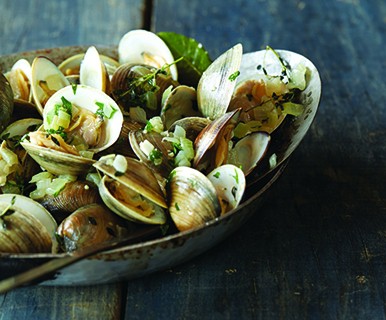
Clams in the Kitchen
Found along the East and West Coasts of the U.S., both hard- and soft-shell clams are mildly salty and have a soft, chewy texture. Hard-shell clams vary in size, with tenderness generally decreasing as size increases. Atlantic hard-shell clams, often called by their Native American name quahog, include the large chowder clam with a shell diameter of at least 3 inches, mediumsized cherrystones, and small, tender littlenecks with a shell diameter of less than 2 inches. Along the West Coast, hard-shell varieties are medium to small and include the Pacific littleneck, Manila, Pismo and the small, sweet butter clam.
Unlike soft-shell crabs, the brittle shell of a soft-shell clam is inedible. The most common Atlantic soft shell is the steamer clam. West Coast razor clams have narrow shells that resemble old-fashioned straight razors. Another West Coast native is the anomaly known as the geoduck with a shell up to 7 inches long and a neck that can grow to 3 feet.
Fresh clams are purchased live in the shell. To test, tap the hard shell; the clam should close tightly. For soft shells, gently poke the neck and the clam should retreat slightly. Before cooking, discard dead clams and those with cracked or chipped shells.
Farm-raised clams are usually cleaned and flushed of sand before they’re sold. To remove the sand in wild-caught clams, cover them with cool tap water in a large bowl. Let the clams sit for 20 minutes to an hour to allow them to filter out sand. Adding cornmeal or black pepper to the water may encourage the clams to spit out more sand. Gently remove clams from the water and scrub the outer surface before cooking.
Clams in the Clinic
Clams are lean, low in calories and rich in protein, but like other shellfish, they are higher in cholesterol. A 3-ounce serving (about 12 medium-sized cooked clams) has about 125 calories, fewer than 2 grams of fat, 22 grams of protein and 57 milligrams of cholesterol. Moderately high in omega-3s at 360 milligrams per serving, clams also are a good source of iron, zinc, potassium, niacin and vitamin B12 and an excellent source of phosphorus. Clams are naturally low in sodium, but canned clams contain added salt.
Clams in Quantity
Purchase clams live in the shell, frozen raw or cooked, or canned. Clams for foodservice are typically chopped and available in multican cases. Frozen clams are available in strips or chopped, often in 5-pound bags. Farm-raised clams have little impact on habitats or other species. Wild-caught clams may be harvested by hand with rakes or shovels or by the less-sustainable commercial dredging method.
Serve clams as appetizers, salad toppers, in chowders and stews, and in pasta dishes and seafood bakes. Cooked clams may be served in or out of the shell or eaten raw (as in sushi). Cook clams gently to prevent toughness. Try steaming them in a small amount of water, wine or broth with added garlic, parsley or other seasonings. Shells should open as the clams cook, which indicates they are safe to eat.
Discard clams that do not open. Clams can be served in the shell or removed and tossed with hot pasta, deep-fried, used in stuffing mixtures, or added to soups such as the tomato-based Manhattan or creambased New England clam chowders. Simulate a traditional New England clam bake by layering onions, potatoes, corn cobs, sausage, lobster, shrimp and clams in a large stockpot. Spanish seafood paella, flavored with saffron and served with rice, typically includes clams.
Store live clams in a porous bag for up to two days in the refrigerator, but never store them in a plastic bag or submerged in water. Shucked clams can be stored for up to four days.
Linguini and Clam Sauce with Andouile, White Beans and Tomatoes
Recipe developed by Roberta L. Duyff, MS, RDN, FAND, CFCS
Prepared with the robust flavors of Andouille sausage, garlic and red pepper flakes, and with the health benefits of white beans and tomatoes, this Cajun-style clam sauce — made with canned clams and tossed with cooked linguini — is an economical, quick and convenient way to feature clams in family meals.
Ingredients
8 ounces dry linguini
2 tablespoons olive oil
4 ounces Andouille sausage, ham or turkey ham, diced in ¼-inch cubes
4 shallots, thinly sliced
6 cloves garlic, peeled and thinly sliced
1/8 to ¼ teaspoon crushed red pepper flakes
2 10-ounce cans minced clams, drained with 3⁄4 cup juice reserved*
½ cup dry white wine
1 15-ounce can white beans, rinsed and drained
1 14.5-ounce can unsalted diced tomatoes, undrained
½ cup coarsely chopped cilantro or flat-leafed parsley, divided
Freshly ground pepper, to taste
¼ cup grated Parmesan cheese
1 lemon, cut in wedges (for garnish)
Directions
- Cook the linguini according to package directions. Drain, return to pot and cover to keep warm.
- Meanwhile, heat the olive oil in a large nonstick skillet over medium-high heat. Add the Andouille sausage, shallots and garlic; sauté for about 2 minutes or until lightly browned. Stir the red pepper flakes into the mixture; cook for 1 minute to blend the flavors. Add the beans, tomatoes, wine and reserved clam juice. Reduce heat to medium; simmer for about 5 minutes, stirring occasionally until it reaches the desired consistency.
- Add the clams and cilantro or parsley. Stir to combine; simmer 1 minute to heat the clams. Season to taste with freshly ground pepper. Add the cooked linguini to the skillet and toss gently. To serve, garnish with Parmesan cheese, the remaining cilantro or parsley, and lemon wedges. Serves 4.
*One 10-ounce can of clams contains 4 ounces of clams and 6 ounces of clam juice.
Also try Steamed Clams with Andouille Sausage.
